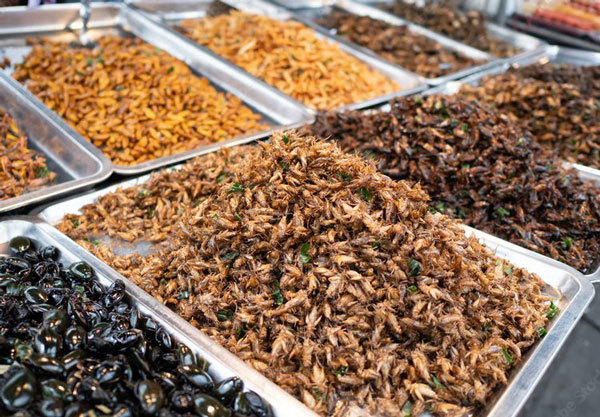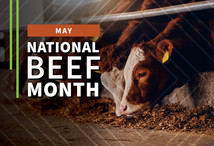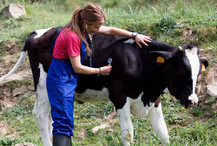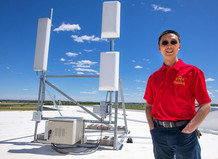|
Having trouble viewing this email? View it as a Web page.

|
|
|
Editor: Lori Tyler Gula, Ph.D. May 4, 2022
Making a Difference
 Fried crickets and other fried insects, courtesy of Adobe Stock.
From Pests to Protein: Edible Insects Emerge as a Sustainable Food Source
Bugs. They get a bad rap. Some bite. Some sting. Some stink. But what if they could be considered beyond their pesky traits? What if certain insects could actually benefit the health of humans, of animals, of the entire planet? Virginia Tech scientists think so, and they have the research to prove it.
|
|
Call for Comments: Preliminary Observations on Collaboration in the Land-grant System
You are invited to comment on the topic of “Collaboration in the Land-grant System.” USDA, through funding from appropriations legislation, asked the National Academies of Sciences, Engineering and Medicine to appoint a Blue Ribbon Panel to examine how collaboration among Land-grant Institutions can be more impactful in addressing the nation’s needs for a successful, sustainable food and agricultural system, and to recommend ways those institutions can better capture and share the collective outcomes of their collaborations. The panel has posted online 17 preliminary observations about the current state of collaboration and is seeking feedback from stakeholders that it will use to inform the planning of a virtual workshop, and ultimately, a consensus report to USDA and Congress. You can find a link to the reference document containing the preliminary observations in the online comment form, which also contains a link to the project website with more information about the panel and a place to subscribe to project updates. Please send comments by Friday, May 6.

May the 4th Be with You
NIFA may not fund light saber or droid research but, with support from NIFA, scientists are developing advanced technologies to meet the complex agricultural challenges faced by the United States and throughout the world. On this May the 4th, learn how scientists at Land-grant Universities use NIFA support to conduct cutting-edge research that helps farmers produce higher quantities of safer and better-quality food, fiber and fuel to meet the needs of a growing population.
May the 4th Be with You graphic, courtesy of NIFA.
|

Beefing Up the Cattle Industry
NIFA works with Land-grant Universities to ensure those involved in the beef industry have access to reliable data and information to help make informed marketing decisions. From research dedicated to enhancing herd health to programs educating farmers and ranchers on various marketing opportunities, NIFA-funded research is helping support cattle producers, feeders and processors across the nation.
National Beef Month graphic, courtesy of NIFA.
|

The Importance of Wildflowers
Almost as diverse as wildflowers themselves are the wildflower-related research and Extension efforts that NIFA funding supports. Several current wildflower research projects are looking at how wildflowers and their associated pollinators can impact and improve traditional production agriculture systems.
National Wildflower Week graphic, courtesy of NIFA.
|

NIFA-Funded Research Works to Strengthen Veterinarian Career Field
NIFA’s Veterinary Services Grant Program and Veterinary Medicine Loan Repayment Program support the needs of the veterinarian career field. Learn more about the impact made by each program and read about a few grant recipients.
Veterinarian performing a check-up, courtesy of Adobe Stock.
|

NIFA’s Evergreen Commitment to Protecting Trees, Forests
This year marks the 150th anniversary of Arbor Day, which began in Nebraska after the newly arrived settlers sorely felt the absence of trees in their new lives on the plains. Now, communities across the country celebrate Arbor Day as a way to honor trees and the special role they play in the health and well-being of our communities and our environment. At NIFA, trees and forests are seen as a critical natural resource.
National Arbor Day graphic, courtesy of NIFA.
|

NIFA-Funded Research and Outreach Helping Producers Meet High Demand for Blueberries
Blueberries are the second-most produced berries in the U.S., after strawberries, according to USDA’s Economic Research Service. Over the past 10 years, the supply of fresh blueberries available for American consumption has increased fivefold. As a result, U.S. production of blueberries has increased rapidly to meet year-round consumer demand. Land-grant Universities across the nation are working to support blueberry producers working to meet this increase in demand by conducting blueberry research and outreach with funding from NIFA.
National Blueberry Pie Day graphic, courtesy of NIFA.
|

Squashing the Spread of the Spotted Lanternfly
USDA is working with states to detect, contain, control and suppress spotted lanternfly, a deadly nonnative invasive pest that threatens American agriculture and natural resources. With support from NIFA, researchers and Extension educators at Land-grant Universities are playing a critical role in conducting research and educating growers, producers, landowners, forestry personnel and the public about the need to be on the lookout for this pest.
Squashing the Spread of the Spotted Lanternfly graphic, courtesy of NIFA.
|

USDA Opens Grants Application to Improve SNAP Customer Service
USDA’s Food and Nutrition Service has announced $5 million in competitive grants are being made available to enhance efficiency and access in the Supplemental Nutrition Assistance Program through process and technology improvements.
A family shops for pasta, courtesy of USDA’s Food and Nutrition Service.
Statements by Secretary of Agriculture Tom Vilsack and HHS Secretary Xavier Becerra on the White House Conference on Hunger, Nutrition and Health
The White House announced its commitment to end hunger, improve nutrition and physical activity, reduce diet-related diseases and close disparity gaps by 2030. As part of this commitment, the White House will hold a conference this fall to catalyze the public and private sectors around a coordinated, whole-of-government strategy to accelerate progress and drive significant change.
USDA Accepts 2 Million Acres in Offers Through Conservation Reserve Program General Signup
Agriculture Secretary Tom Vilsack announced USDA is accepting more than 2 million acres in offers from agricultural producers and landowners through the Conservation Reserve Program General signup, the first of the program’s multiple signups occurring in 2022. With about 3.4 million acres expiring this year, Vilsack encourages producers and landowners to consider the Grassland and Continuous signups, both of which are currently open.
Actuality: Vilsack Gives Update on Avian Influenza Situation
Agriculture Secretary Tom Vilsack gives lawmakers an update on the avian influenza situation.
A Network to Open Opportunities in Rural America
A new Rural Partners Network is designed to help rural leaders find and apply for federal programs such as those supporting infrastructure improvements or economic development.
|

Timing is Everything with Fertilizer
Spring is underway and the plants are blooming. Plants perform best when they receive the optimum amount of sunlight, appropriate amounts of water and essential nutrients for good growth and production of flowers and fruit. Learn how to optimize plant growth by knowing how and when to fertilize from LSU AgCenter Horticulturalist Heather Kirk-Ballard.
A good slow-release fertilizer and use of liquid fertilizer, when needed, will help produce the most flowers and fruit. Photo by Heather Kirk-Ballard, LSU AgCenter.
|

UConn 4-H: Making Magic Happen at the Connecticut Beardsley Zoo
The call of birds in the distance accompanies us while walking through the farmyard of Connecticut’s Beardsley Zoo in Bridgeport. Cattle amble up to the fence in greeting, and bison graze on a hillside in the distance. UConn 4-H youth members experience this twice per month with the Connecticut Beardsley Zoo 4-H Club. It becomes a transformative life experience that shapes their college plans and careers.
Linda Tomas (second from the right) has mentored over 150 youth in her 35 years as a UConn 4-H volunteer with the Beardsley Zoo. Photo courtesy of UConn Extension.
|

Innovation at Work: Growing the ‘Broadband Prairie’ for Smart Agriculture, Connected Rural Communities
It’s a 40-minute road trip from Ames to Zearing in Iowa, with a few right-angle turns to the north and east. This time of year, you’ll drive past fields that are black and damp, still stubbled with the remains of last year’s corn and soybean crops. You’ll also drive past rows of turbines spinning in the spring winds, harvesting a new cash crop, under the leadership of Iowa State University.
Iowa State's Hongwei Zhang is doing all he can to help grow what he calls a "Broadband Prairie" for rural Iowa and beyond. Photo by Christopher Gannon, Iowa State University.
|

May 5: National Science Foundation Convergence Accelerator Webinar
National Science Foundation will host a webinar May 5 from 3 to 5 p.m. EDT for prospective grantees to learn about its Convergence Accelerator, a new funding opportunity focused on three new research track topics: Enhancing Opportunities for Persons with Disabilities, Sustainable Materials for Global Challenges, and Food & Nutrition Security.
National Science Foundation logo.
|

May 9: Foundational and Applied Science RFA Partnership Opportunity Webinar
NIFA will host a webinar May 9 at 3 p.m. EDT to provide information on the AFRI Foundational and Applied Science RFA’s Partnership Opportunity. The Partnership Opportunity allows applicants to request an additional $150,000 for applications that include significant collaboration involving strengthening eligible institutions. During this informational webinar, National Program Leaders from each of the participating program area priorities will give a brief description of their program, proposal submission deadlines and maximum award amounts for partnerships.
Webinar graphic, courtesy of NIFA.
May 18: NIFA Employment Opportunities Webinar
NIFA will host an Employment Opportunities Webinar on May 18 at 2 p.m. EDT. This webinar will review various employment positions at NIFA. It will provide overviews of the available roles, how to view NIFA vacancy postings online, tips for navigating USAJobs, and NIFA staff will be available to answer your questions.
May 24-26: Making Climate-Smart Agriculture Work
The NIFA-funded Agricultural Model Intercomparison and Improvement Project will host a national conference May 24-26 on Making Climate-Smart Agriculture Work. The focus of the virtual conference is to share information and best practices regarding integrating science, modeling and economics to help farmers, ranchers and foresters mitigate and adapt to the challenges of climate change.
|
Tribal Colleges Extension Program: Special Emphasis
 College students study together, courtesy of Getty Images.
The purpose of the Tribal Colleges Extension Program (TCEP) is to enable 1994 institutions to deliver science-based, culturally relevant Extension education programs designed to address public needs and improve quality of life. The TCEP is intended to be a component of the applicant 1994 institution's Land-grant roadmap or strategic planning process. To the extent practicable, priorities should reflect NIFA's national critical needs areas: development of sustainable energy; increased global food security; adaptation of agriculture and natural resources to global climate change; reduction of childhood and adolescent obesity; and improved food safety. Application deadline: June 14. For more information, read the funding announcement.

Greenwire: Vilsack Predicts Big Demand for ‘Climate-Smart’ Food Projects
Agriculture Secretary Tom Vilsack said he expects a new pilot program aimed at reducing food production’s greenhouse gases will generate more applications than his department can fund. Speaking to agriculture reporters, Vilsack said he sees a “keen interest” so far in the program, which will award grants for projects that measure greenhouse gas impacts from various practices in farming, forestry, and food processing and distribution.
Agriculture Secretary Tom Vilsack testifying on Capitol Hill in October 2021.
Credit: Francis Chung/E&E News.
|

Funding Opportunity: The GusNIP - Nutrition Incentive Program presents the opportunity to bring together stakeholders from various parts of the food & healthcare systems to foster understanding of how they might improve the health & nutrition status of participating households.
|

Meet Rizana Mahroof!
Rizana serves as a national program leader in the Division of Community and Education.
"I was attracted to NIFA because NIFA is spearheading the advancement of agriculture-related sciences by promoting sustainable agriculture while adopting modern technologies and addressing climate change."- Rizana
Interested in joining NIFA’s team? Check out our Career Opportunities page for current openings.
Employee Spotlight Rizana Mahroof graphic, courtesy of NIFA.
|
|
|
|
NIFA’s mission is to invest in and advance agricultural research, education, and extension that solve societal challenges. NIFA’s investments in transformative science directly support the long-term prosperity and global preeminence of U.S. agriculture. Keep informed about NIFA, USDA, our land-grant and non-land-grant university partners, and stakeholders with the NIFA Update. Read past issues online, sign up for email updates or follow us on Twitter @USDA_NIFA, #NIFAImpacts or LinkedIn @usda-nifa.
If you wish to submit a news item or information, send an email to NIFAUpdate.
USDA is an equal opportunity lender, provider, and employer.
|
|
|
|